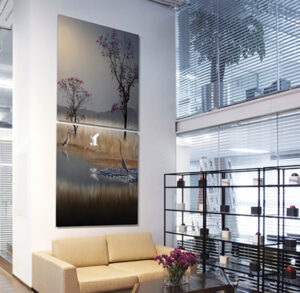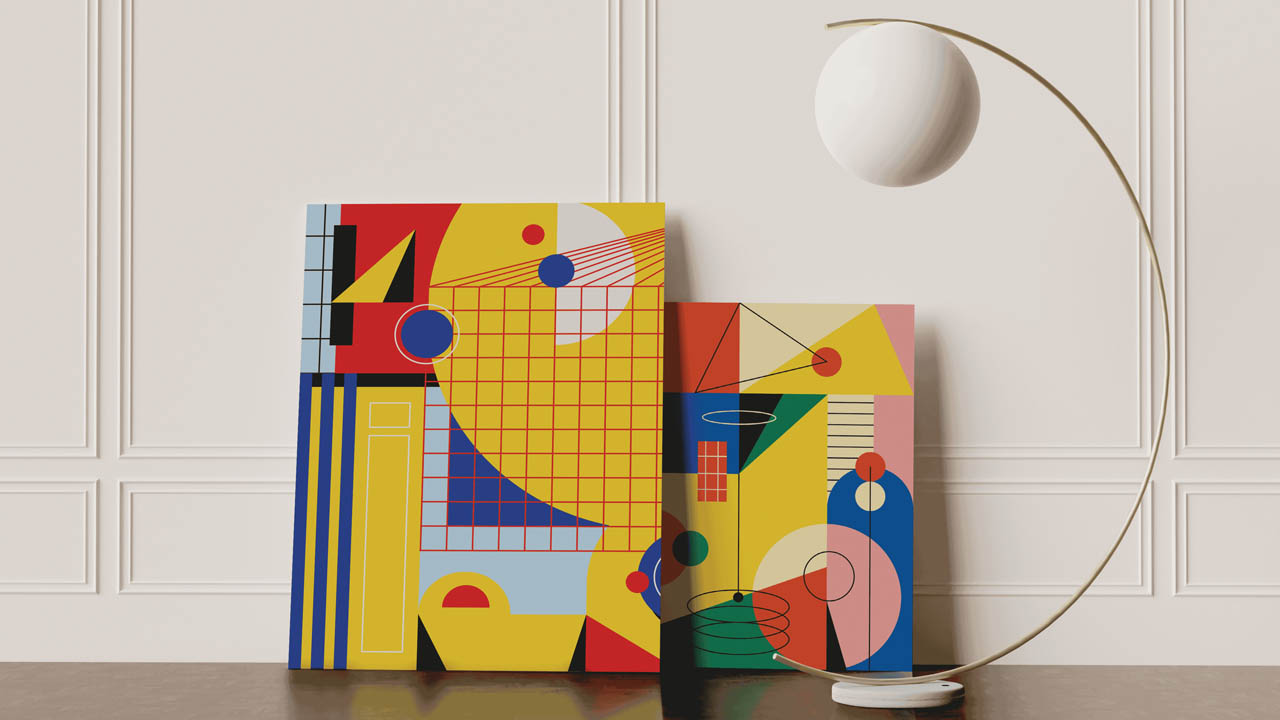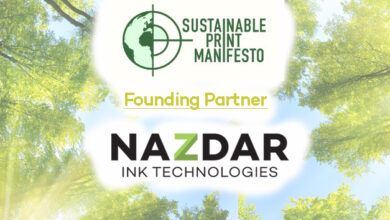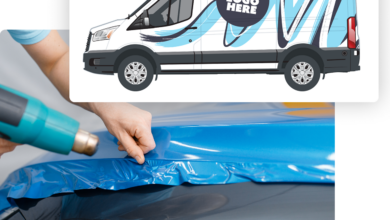When a painter plans to create their latest masterpiece, they look for the finest papers and a full palette of colors to help achieve their message. To “paint your next masterpiece” is to find inspiration, create, and experience life to the fullest, to borrow from Bob Dylan’s reflections in his song “When I Paint My Masterpiece.” That is, while aiming for a masterpiece is aspirational, the process of art is about making more art. This is much the same for wide-format shops and photographers who require the right tools to produce fine art and photographic print projects for their clients. We spoke to several suppliers and asked them what the differences and similarities between canvas, fine art, and photographic media and inks are, which ones are best for different projects, as well as tips for getting the most out of them.
New display options

“We’re seeing more creativity in the way artwork is presented, with unique framing approaches and a rise in printing on alternative substrates such as metal, acrylic, and wood,” said Andy Everding, national accounts manager at IT Supplies, which operates as a reseller and distributor of the papers, inks, and technologies used to produce fine art and photographic prints. “These mediums allow artists and photographers to push beyond traditional papers and create distinctive display pieces. That said, the overall fine art/photographic market remains fairly stable, with many foundational practices unchanged over the years,”
he added.
Everding explained that when choosing the media to output to, there are both similarities and differences between canvas, fine art, and photographic papers. “All three can have archival qualities and are most often produced using digital inkjet printers, with aqueous inks being the most popular choice. High-production canvas, however, is typically printed with latex or solvent inks for added durability. The biggest distinctions come down to surface, sheen, and how each medium is best displayed.”
Jeff Smith, product manager, professional imaging, Epson America, added that one of the great things about working in fine art/photography is the wide range of media available. “Artists and photographers are no longer confined to a few media types; they can explore everything from traditional photographic papers to fine art media, canvas, and more.”
Smith said that with so many choices and options, it has become increasingly important for artists to educate themselves on the different media to make the best choice for their work. “Media manufacturers will often introduce subtle variations in how they manufacture specific media. For example, one company may offer an optical brightening agent (OBA)-free baryta paper, while another includes optical brightening agents.”

“Other key distinctions include cotton fiber vs. alpha-cellulose bases, and thickness and lightfastness ratings. Fortunately, there are resources that can provide background and education on these media parameters, including Epson Print Academy. Each of these media will completely transform how viewers experience the final print and can make a difference in the details and permanence,” he added.
Smith also noted that while canvas, fine art paper, and photographic papers are all popular choices for displaying artwork, each offers distinct qualities. “Canvas is comprised of a cotton-poly base and is available in matte, satin, and glossy finishes. It can be stretched for a frameless presentation and is widely used in wedding and portrait photography, as well as the decor market. Fine art media encompasses a range of paper types. They tend to be comprised of a cotton fiber base and can have smooth to textured matte surfaces. These papers are popular with artists for both the fine art look and how the paper feels when held. Photographic papers predominantly have a smooth surface and offer the widest color gamut and the richest blacks. These qualities make them the go-to choice for many photographers who are producing exhibition-quality prints.”
Christopher Martin, senior marketing specialist at Canon USA, pointed out that more and more studio photographers are bringing large-format printers in-house for the first time, typically starting at 24“, rather than outsourcing as these devices become more affordable and easier to use. “We’re seeing more and more photographers and framing companies, for instance, printing their own work instead of outsourcing to a lab. This has allowed them to not only save money in the long run but also control the quality of the output from the printer. The UV and latex market tends to offer more interior decor trend products to a growing and expanding marketplace.”
Martin explained that photographic papers, depending on the ink set, can provide archival images that are used in photography for portraits, weddings, and landscape photographs. Choices include glossy, satin, or luster surfaces and more premium weights as well. “It’s fast-drying and has a resistance to the effects of lighting, making it perfect for exhibition and galleries. In the UV and latex market, the photographic papers include fewer choices — glossy and satin — alternative matte-coated materials are used as well, but for more interior decor or poster images.”
More bolder colors

Dave Hawkes, media product manager at Roland DGA, noted that one consistent need in the world of digital art is for greater gamut. The ability to print with more colors provides the artist with the ability to explore the possibilities of their work. This doesn’t just allow for beautiful, bright images — it also enables greater depths of color and shadows that provide more detail to the artwork.
“Perhaps the most notable change we have seen in the industry is a dramatic increase in texture options. The impact of this has been striking — printers, media, and ink are all playing significant roles in adding the tributes of texture. UV ink allows for the easy creation of textures using the layering of the ink as well as the glossy highlights.”
Hawkes continued, “In addition to UV ink, DIMENSE digital printing [combines] heat, ink, and media to create custom textures without the need for multiple layers, thus allowing for less ink usage and reduced print time in a single-pass system.”
He said that the difference that texture makes to an image is like the difference that color made when only black and white film was available. Incorporating textural effects makes an image come alive and stops people in their tracks.
Hawkes pointed out that using the right media with the right image can make all the difference. “Canvas images can ‘stand on their own’ without the need for elegant frames or borders. Canvas provides a durable substrate that can be archival, plus high-gamut images stand out on this material, and you have the option of choosing from high-gloss, semi-gloss, or matte.”
He explained that fine art paper can reproduce classic images without the issues that time and the environment can have on historical images. Art paper works with a matte-based substrate that needs to be handled delicately to avoid creases and tears. A photo-based paper brings out the detail and the gamut of images. These types of paper work easily with matte, semi-gloss, or gloss-based substrates and provide a softer contrast. Like art paper, photo-paper images also need to be handled delicately.”
Pros & cons
Everding said that the right choice of media depends on the application. “Canvas is great for gallery wraps and durable, frameless displays, though it sacrifices some detail compared to paper. Fine art paper delivers the longest archival life and unmatched fidelity to original works, but typically requires framing and UV protection. Photographic paper provides the most cost-effective option with vivid detail, though it lacks the texture and tactile qualities of canvas or fine art papers. Ultimately, it comes down to the intended display, longevity requirements, and whether the print is meant to be timeless or swapped out for newer images over time.”
He added that when it comes to inks, there are pros and cons of giclee (aqueous pigment) inks vs. UV, latex, and solvent inks. “Technically, ‘giclee’ simply means ‘to spray’ in French, so any inkjet technology qualifies. However, the term has come to be associated with fine art printing using aqueous pigment inks, which offer the best archival performance. These are the preferred choice for fine art and photographic papers where longevity and color accuracy matter most.”
Hawkes added that since canvas already has a textured surface, it will not work well with layered ink types. It can create magnificent images, but texture can lose some of its detail when printed on this media. Another downside is that canvas is a bulkier, heavier substrate that will cost more to ship. “Art paper provides a matte image with softer contrast for museum-grade images. It also works well with textured imaging. Photo papers provide beautiful detail and gamut, while also offering a lot of flexibility when it comes to surface types. They also tend to be more affordable than other options. The downside to using photo paper is that this media is typically more fragile and scratches easily, therefore requiring careful handling.”

Thinking about ink
As far as the ink, Hawkes noted that giclee prints produce stunning images. Giclee’s pigment ink provides a base that makes it much easier to meet a specific gamut and achieve smooth gradations for applications like archival images. However, pigmented ink can have limitations on the drop size and resolution of the image. In addition, pigment inks often require lower print speeds and higher levels of printer maintenance.
Hawkes said that UV inks allow artwork to be printed on almost anything, opening up a new world of creative options. It allows the user to easily add textural effects to prints and pinpoint the use of gloss with amazing results. One possible downside is that the gamut is usually reduced due to the vast array of substrates that can be printed on. The UV ink and layer process can also take longer than other inkjet types and tends to require more maintenance.
He added that solvent-based inks are widespread in the industry. “They offer a vivid gamut, high production rates, and there are many affordable options. Most offer an archival life span as well as environmental advantages. Water-based inks can provide excellent colors, and they’re also environmentally friendly. However, they may not have the archival qualities sometimes demanded in the art market.”
Martin said that aqueous inks are not categorized as giclee inks, but they are standard pigmented inks with excellent color gamut, print quality, and lightfastness. “Giclee printing uses high-end media and an excellent gamut ink set to provide these prints. UV and latex inks are considered to yield smaller color gamuts but can cater to a wider variety of applications and at faster output speeds that fill the graphic space, interior decor, and commercial spaces for these types of media products.”
Tips & tricks

Martin added that when it comes to getting the best resolution/colors, using an ICC profile is always recommended. He added that Canon also provides .am1x files for a variety of media. These files set printer parameters (such as ink density limits, print head height, media vacuum strength, media roll length, custom media name, etc.) to be used for each media type that can then be selected from both the printer’s control panel (when loading media) and the printer driver (when printing).
Everding said it’s important to note that latex and solvent inks provide excellent durability and elasticity, making them ideal for stretched canvas gallery wraps. UV inks have gained popularity for rigid substrates such as metal, wood, and acrylic, but because they lack strong archival properties, they’re less common in fine art applications where long-term preservation is critical.
When asked about tips for best resolution and colors that pop, Everding said, “Modern printers can include up to 12 inks to reproduce nearly the full visible color gamut, but maximizing results requires good color management. We recommend creating custom ICC profiles for each paper type. This can be done in-house with a spectrophotometer or outsourced to a color consultant. Every substrate has different white points and ink absorption levels, so proper profiling ensures accurate color reproduction and consistent results across projects.”
As far as applications, Everding said that canvas is best used for abstract and modern art, bold landscapes, oil/acrylic reproductions, contemporary decor, and family portraits. “Fine art paper is ideal for watercolors, pen-and-ink drawings, pastels, charcoal, black-and-white photography, museum-quality reproductions, and limited editions. Lastly, photographic paper is best used for portrait photography, landscapes, architectural photography, high-contrast or commercial imagery, and vibrant color photographs.”
Smith said that for fine art applications, pigment-based ink is the most popular due to its print permanence characteristics. “To achieve the best quality, it comes down to workflow and is not related to media. When possible, work from RAW files in the widest color space (such as ProPhoto RGB) and in the greatest bit depth (specifically 16 bit) at 360 PPI, not DPI. Each media lends itself to different vertical markets and applications. These applications overlap, and include photography portraits, weddings, landscapes, advertising, fine art reproductions, home decor, gifts, and collectable prints, and more,” he concluded.




